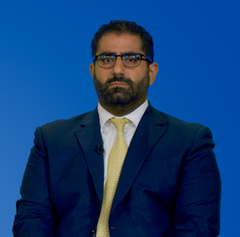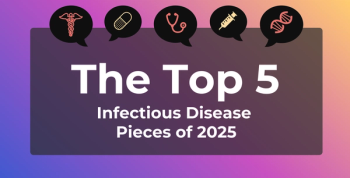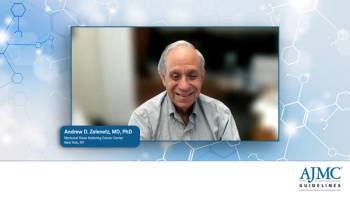
Challenges and Benefits of Next-Generation Sequence Testing in mNSCLC
Experts explore the utilization of next-generation sequencing, including liquid biopsies, in mNSCLC Diagnosis.
Episodes in this series

Mark Socinski, MD: What are your thoughts about the future of…finding other targets, or how should we be looking at that?
Joshua Sabari, MD: I think we’ve probably exhausted most of the targets that are going to benefit large patient populations. I mean, there are still very niche targets. And our G1, for example, is one of them where we don’t yet have FDA-approved match targeted therapies. And we’re working on that. But I don’t think we’re going to identify new, driver alterations that are oncogenes, that we can target with a tyrosine kinase inhibitor. Despite sequencing more and more patients, we still have about a 30% to 40% patient population [in whom] we don’t identify a driver alteration. And biologically there may be other things at play, proteomic or protein expression abnormalities here. So I think we’ve pretty much exhausted what we’re going to identify. Now, what I don’t think we’ve exhausted is development of new targeted therapies to target resistance mutations. So I do think that the field will sort of move into more next-generation therapeutics for the driver alterations that we already have identified. What are your thoughts on that? Do you think we’re going to identify more alterations?
Mark Socinski, MD: I think we may identify some niche ones, like the energy one fusion and stuff like this that are quite rare. And we’ll be developing things from this. But I agree with you. The challenge of acquired resistance is in front of us. And so I think that’s the key thing. So for [practitioners] like you and me, who do lung cancer for a living, basically…I know it’s true in my practice—I do comprehensive genomic testing on all patients. However, we see we’ve had a couple of abstracts at ASCO [American Society of Clinical Oncology Annual Meeting] the past couple of years where even the abstract looked at 5 targets. The 5 I think were EGFR, BRAF, ROS1, and ALK plus PD-L1, but about half the patients actually got all 5 and only about 38% or so had NGS [next-generation sequencing] testing. So there are clearly issues out there in the community. What’s the message that should be put forward for them?
Joshua Sabari, MD: I think there are a lot of barriers to next-generation sequencing. First off, the tissue is really an issue, right? If you don’t have sufficient tissue, it’s hard to do a full, broad-panel next-generation sequencing. Upward of 20% to 25% of our samples, especially if they’re finding…can be…failed or insufficient cellular material to do the testing. So one of my messages when I see a patient in second opinion, particularly from the community where we don’t have sufficient tissue, is let’s rebiopsy, right, let’s do a bronchoscopy. It is so important that we identify what is driving this patient’s tumor that we need to get tissue again.
Mark Socinski, MD: Yeah. There’s nothing wrong with a second biopsy.
Joshua Sabari, MD: No, nothing at all. And then I think the other thing is access, right? Unfortunately, a lot of our patients do not have access. And even in my own practice, if I order plasma and tissue, sometimes patients get a bill from their carrier. So I think access remains an issue. And even in our own system where we have a public and a private [system], we’re about 99% in the private system and about 80% in the public system. So there are discrepancies, disparities there, [and] we need to do better. What are you seeing in your practice in Florida?
Mark Socinski, MD: Well, I think it’s not too dissimilar from that. We don’t necessarily have—again, mine is a niche practice—I only see referral of [patients with] lung cancer and that sort of thing. So they kind of get what I would consider the standard approach. We haven’t had much of an issue in Central Florida about reimbursement, to be honest. The companies have been quite benevolent with regard to that. And so I think that’s a good thing. It allows us to get the information we need in a timely fashion. I do agree with you [on] the issue of a second biopsy; sometimes that’s the most important thing that we do. We shouldn’t have to do a second biopsy. I always say to anyone who will listen, “Let’s do the right biopsy the first time so we get everything we need for that particular patient.” But, and this is the question that I’ll throw back at you.… If you turn the clock back to 2014, 2015, 2016, doing a lot more second biopsies, but plasma testing has changed things so much. Tell me how you’ve seen that over the past, say, 5 years as we’ve used more plasma-based testing and the technology has become better to identify these drivers. It really has changed the landscape.
Joshua Sabari, MD: It has. So plasma testing or liquid biopsy or circulating-tumor DNA has really revolutionized my care for patients. You know, often where you don’t have enough tissue and you get a liquid biopsy and you identify that EGFR mutation, you know you can trust that. That is what the patient has in their tumor. And you can treat it. I have a couple of patients in my practice in their 80s or 90s who didn’t want a biopsy, and I’m not recommending that, but you know you can treat based on the plasma NGS. You don’t have the histology right, you can’t understand the architecture, but it does help. It does save us. Now, I still recommend doing biopsies in patients, and I use liquid biopsy more at the time of resistance to better understand the heterogeneity. And I think these are 2 tests with 2 different amounts of information. Tissue remains the gold standard, but very slow turnaround time. The plasma gives you more of a breadth of what’s going on, you know, all around. But the turnaround time is phenomenal, right? Five to 7 days on average in our practice.
Transcript is AI-generated and edited for clarity and readability.
Newsletter
Stay ahead of policy, cost, and value—subscribe to AJMC for expert insights at the intersection of clinical care and health economics.










































